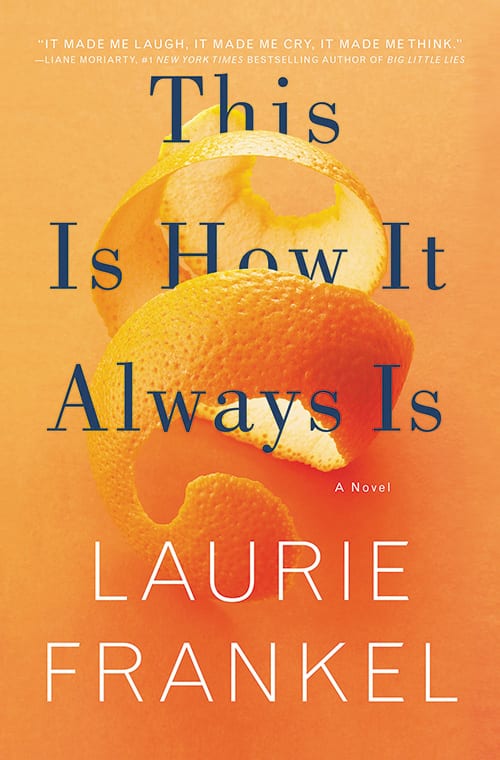2 recent books — one a novel, one a memoir — explore the boundaries of a family

Laurie Frankel
 This Is How It Always Is by Laurie Frankel (Flatiron Books 2017) $25.99; 329 pp.
This Is How It Always Is by Laurie Frankel (Flatiron Books 2017) $25.99; 329 pp.In the beginning was Roosevelt, known to his loved ones as Roo. Not long after he was born, Ben entered the family. Then the twins, Orion and Rigel, arrived and so Rosie Walsh, still hoping for a girl baby, did everything the Talmud recommended she do next. Months later, she and her husband, Penn, welcomed… Claude.
That was OK. Another boy in their raucous, rowdy family of boys was fine — Rosie and Penn loved them all. They were happy in their big, rambling, open farmhouse just outside of Madison, Wisc. Rosie loved her job; Penn worked on his novel; and Claude, it turns out, dreamed of being a girl.
It started when, as do most parents, Rosie told Claude that he could “be anything” he wanted to be someday. Claude was 3 and loved dress-up; it didn’t seem odd to let him wear dresses at home. But soon, home wasn’t enough, and Claude tantrumed until he was allowed to wear dresses to preschool, though he was told that he’d have to use the nurse’s station bathroom and his teacher was “not happy.”
Still, Rosie and Penn were willing to do what it took to make Claude feel secure. With his dresses and pink tones, he was a confident child; without, he was sullen and sad. None of his classmates minded his clothing. His brothers never gave it a second thought. Claude was simply Claude, until he asked his parents to call him Poppy.
And that was fine, too, especially when the family moved to another state and it was easier to keep quiet … until it wasn’t.
Until Poppy started growing up, the world became a vicious place, and secret-keeping couldn’t last forever.
And so, here’s the thing: once you’ve started reading This Is How It Always Is, you might as well just clear your schedule. Cancel all appointments. You won’t want to do anything but read, so just give in. Blame it on the book.
Part of the appeal, I think, is in the way that author Laurie Frankel writes: there are no airs, no try-to-impress-you words, nothing uppity. Her characters are normal people with everyday lives, trying to maintain that normalcy, and Frankel writes like they might talk: with down-to-earth matter-of-factness and a fast dash of humor that winds its way through a serious topic. And on that topic, you’ve perhaps heard it before (or something similar) but not in a voice like this, and not quite as enjoyable.
One more thing: be sure to read Frankel’s after-notes, which brings her novel full-circle and will make you smile. But don’t peek; instead, start This Is How It Always Is from the beginning and savor it properly. It’ll make you want to tell everyone.
 Transitioning Together: One Couple’s Journey of Gender and Identity Discovery by Wenn & Beatrice Lawson (Jessica Kingsley Publishers 2017) $19.95; 214 pp.
Transitioning Together: One Couple’s Journey of Gender and Identity Discovery by Wenn & Beatrice Lawson (Jessica Kingsley Publishers 2017) $19.95; 214 pp.Long before they met, Wendy and Beatrice had a lot in common: both came from families of similar sizes. Both had fathers that “didn’t have a head for figures” and mothers who ran the family businesses. Wendy and Beatrice are both on the autism spectrum. The main difference: Wendy was a married woman.
They met one afternoon when Wendy, her husband and their four children were living in the home of a well-to-do family that had just hired an au pair. The shy young woman didn’t speak English and Wendy didn’t speak Swiss German, but when Wendy was asked to help the girl to settle in, Beatrice proved to be a quick study. She easily learned a new language and she and Wendy forged a close friendship. Both seemed only a little surprised when that friendship turned into love.
Wendy, who’d had health issues most of her life, never considered falling in love with another woman, but it felt right.
Beatrice had an inkling that she was a lesbian, but she shunned the word, afraid that it would “be an embarrassment” to her family. Even so, she settled into a relationship which was tender and fragile from the start.
Wendy and her family moved from England to Australia as her abusive marriage was crumbling. Beatrice was unable to make the move with her beloved, due to Australia ’s immigration laws. They ultimately figured out a way to be together physically; once Wendy’s divorce was final, they knew they’d be together legally as well.
But even after their wedding, Wendy wasn’t happy. Never comfortable in her body, she felt sure that something was missing, so she sought her “tribe” before understanding that she needed to transition to become the man he’d always known he was. And that was something Beatrice wasn’t sure she could handle.
From its very beginning, Transitioning Together is a tough read. There are a lot of preliminaries to wade through to get to the start of the actual story, and then there’s a lot of confusing set-up that identifies Wenn and Beatrice Lawson by their relative ages, rather than by name. While it’s helpful, later, to have a change in font to delineate who is weighing in, you might continue to be baffled by the semi-linear nature of what is mostly Mr. Lawson’s version.
Yes, tenacious readers who can bear with this dual memoir will get a double-edged peek at the emotional process of transitioning for both partners, through the added, unique perspectives of autism and age.
That’s worth the patience — if you have it. Indeed, this book could be more for professionals than for anyone else; general audiences may enjoy Transitioning Together, but only by a hair.
— Terri Schlichenmeyer
This article appeared in the Dallas Voice print edition July 28, 2017.
















